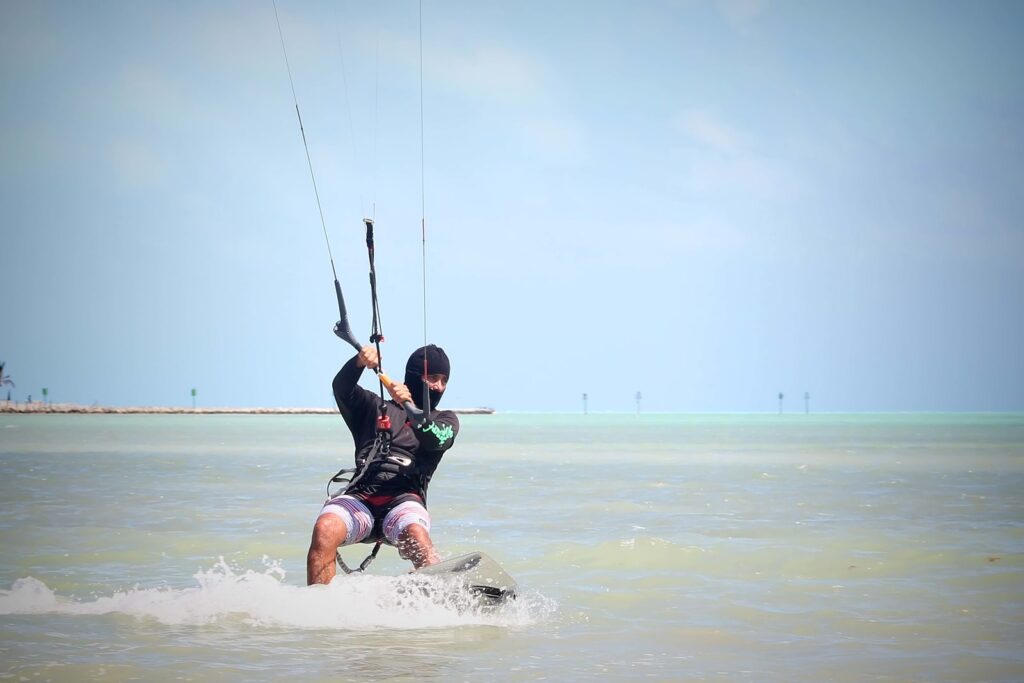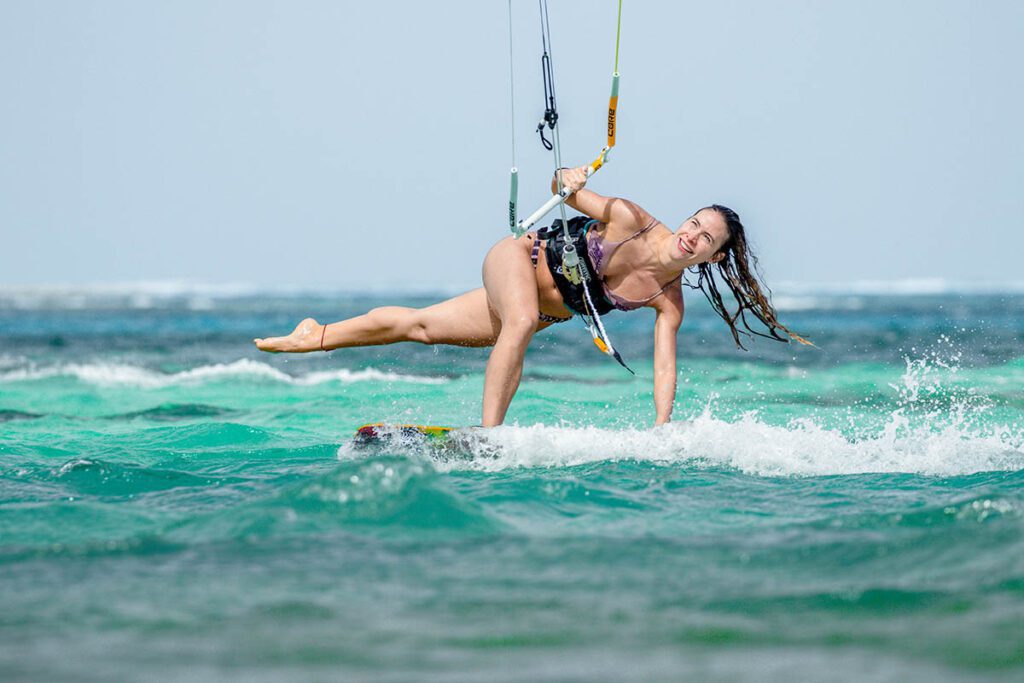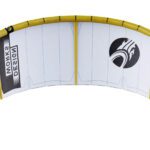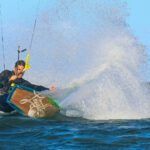
Kitesurfing 101: Everything You Need to Know.
Table of Contents.
What is Kitesurfing?
How Does Kitesurfing Work?
What Equipment is Needed for Kitesurfing?
What are the Different Types of Kites Used in Kitesurfing?
How Do I Choose the Right Size Kite for My Weight and Wind Conditions?
What Safety Precautions Do I Need to Take When Kitesurfing?
How Do I Learn to Kitesurf?
What are the Best Locations for Kitesurfing?
What are Some Common Kitesurfing Terms and Lingo?
Kitesurfing 101, also known as kiteboarding, is a thrilling water sport combining surfing, windsurfing, and paragliding elements. It involves using a kite to harness the power of the wind and propel yourself across the water on a board. This article will cover everything you need to know to start kitesurfing, including how it works, the equipment you’ll need, safety precautions, and more.
What is Kitesurfing?
Kitesurfing is a water sport that involves using a kite to pull yourself across the water on a board. It’s a relatively new sport, invented in the 1990s by Frenchman Bruno Legaignoux. Since then, it has become increasingly popular worldwide, with dedicated kitesurfing spots in many coastal areas.
How Does Kitesurfing Work?
Kitesurfing works by harnessing the power of the wind to propel yourself across the water on a board. The kite is attached to the rider by a harness, which allows them to control the kite’s movements. The rider can control their speed and direction by changing the kite’s angle in the wind. The rider stands on a board, similar to a wakeboard or surfboard, and uses the kite to pull themselves across the water.
What Equipment is Needed for Kitesurfing?
To get started with kitesurfing, you’ll need a few critical pieces of equipment:
- Kite: The kite is the essential piece of equipment in kitesurfing. Many different types of kites are available, including inflatable and foil kites. The type of kite you choose will depend on your experience level and the conditions you’ll be kitesurfing in.
- Board: You’ll also need a board to stand on while kitesurfing. Kitesurfing boards are similar to wakeboards or surfboards but are specifically designed for kitesurfing.
- Harness: The harness attaches you to the kite and allows you to control its movements.
- Control Bar: The control bar controls the kite and adjusts its angle in the wind.
- Safety Gear: It’s essential to wear safety gear while kitesurfing, including a helmet and a flotation device.
What are the Different Types of Kites Used in Kitesurfing?
There are two main types of kites used in kitesurfing: inflatable and foil kites.
Inflatable kites are the most common type of kite used in kitesurfing. They are made of a series of inflatable tubes that give the kite its shape. Inflatable kites are easy to use and provide much power, making them a good choice for beginners.
On the other hand, fuel kites are made of fabric and are held open by a series of air pockets. Foil kites are more advanced than inflatable kites and require more skill. They are also more expensive than inflatable kites.
How Do I Choose the Right Size Kite for My Weight and Wind Conditions?
Choosing the right size kite is essential for a safe and enjoyable kitesurfing experience. The size of the kite you need will depend on your weight and the wind conditions you’ll be kitesurfing in.
Generally, heavier riders will need larger kites than lighter riders. Wind conditions also play a role in kite size selection. Weaker wind conditions require more giant kites, while stronger ones require smaller ones.
What Safety Precautions Do I Need to Take When Kitesurfing?
Kitesurfing can be a dangerous sport if proper safety precautions aren’t taken. Here are some safety tips to keep in mind:
- Always check the weather conditions before kitesurfing. Avoid kitesurfing in stormy weather or strong winds.
- Ensure you have the proper safety gear, including a helmet, a flotation device, and a wetsuit if necessary.
- Learn how to launch and land your kite correctly. This is one of the most dangerous parts of kitesurfing and requires careful attention to safety.
- Never kitesurf alone. Always have a partner who can help you in case of an emergency.
- Know your limits. Only attempt tricks or maneuvers that are within your skill level.

How Do I Learn to Kitesurf?
Learning to kitesurf can be a challenging but rewarding experience. Here are some steps to get started:
- Take a lesson: The best way to learn to kitesurf is to take a class from a certified instructor. They will teach you the basics of kite control and safety.
- Practice on land: Before hitting the water, it’s essential to practice on the ground. This will help you get a feel for the kite and how it moves in the wind.
- Start in calm conditions: When ready to hit the water, start in fair conditions with light winds. This will make it easier to control the kite and board.
- Progress slowly: As you become more comfortable with the basics, you can try more advanced maneuvers. But always progress slowly and with caution.
Is Kitesurfing a Dangerous Sport?
Kitesurfing can be a dangerous sport if proper safety precautions aren’t taken. However, following the appropriate safety protocols and progressing reasonably, kitesurfing can be a safe and thrilling activity.
What are the Best Locations for Kitesurfing?
Kitesurfing can be done in many different locations around the world. Some of the best spots for kitesurfing include:
- Tarifa, Spain
- Maui, Hawaii
- Cabarete, Dominican Republic
- Cape Town, South Africa
- Cumbuco, Brazil
What are Some Common Kitesurfing Terms and Lingo?
Here are some standard terms and terminology used in kitesurfing:
- Kite: The inflatable or foil device that provides the power for kitesurfing.
- Board: The platform that the rider stands on while kitesurfing.
- Harness: The device attaches the rider to the kite and allows them to control its movements.
- Control Bar: The device used to control the kite and adjust its angle in the wind.
- Tacking: Turning the board while kitesurfing to change direction.
- Jumping: Using the power of the kite to launch into the air.
Conclusion.
Kitesurfing is a thrilling water sport that combines the wind’s power with the rider’s skill. Following proper safety protocols and progressing reasonably, kitesurfing can be a safe and enjoyable activity for people of all ages and skill levels. Whether you’re a beginner or an experienced rider, there’s always something new to learn in kitesurfing.
FAQs.
- Is kitesurfing a good workout? Kitesurf is a full-body workout that engages your core, arms, and legs. The constant motion of riding the waves and controlling the kite requires strength, balance, and endurance.
- Do I need to be a strong swimmer to kitesurf? While being a strong swimmer is always a plus, kitesurfing is not necessarily required. However, it is essential to be comfortable in the water and to wear appropriate safety gear, such as a life vest or buoyancy aid.
- How much does kitesurfing equipment cost? The cost of kitesurfing equipment can vary widely, depending on the brand, quality, and type of gear you choose. On average, you can expect to spend anywhere from $1,500 to $3,000 for a complete setup, including a kite, board, harness, and safety equipment.
- Can I kitesurf in any weather conditions? No, kitesurfing is highly dependent on wind conditions, so it is essential to choose a location and time of day when the wind is strong enough to lift the kite but not so strong that it becomes dangerous.
- Are there any age restrictions for kitesurfing? There is no official age restriction for kitesurfing, but riders should generally be at least 12 years old and in good physical condition. Children under 18 should always be supervised by an adult when kitesurfing.
Author
Latest entries
 WatersportsSeptember 16, 2024Cabrinha Moto X: Enjoy the Ride
WatersportsSeptember 16, 2024Cabrinha Moto X: Enjoy the Ride WatersportsMay 19, 2024Cabrinha 2024 Moto XL Review: The Ultimate Lightwind Kite
WatersportsMay 19, 2024Cabrinha 2024 Moto XL Review: The Ultimate Lightwind Kite WatersportsDecember 16, 2023Kiteboarding Travel
WatersportsDecember 16, 2023Kiteboarding Travel WatersportsDecember 14, 2023RED BULL KING OF THE AIR 2023
WatersportsDecember 14, 2023RED BULL KING OF THE AIR 2023




